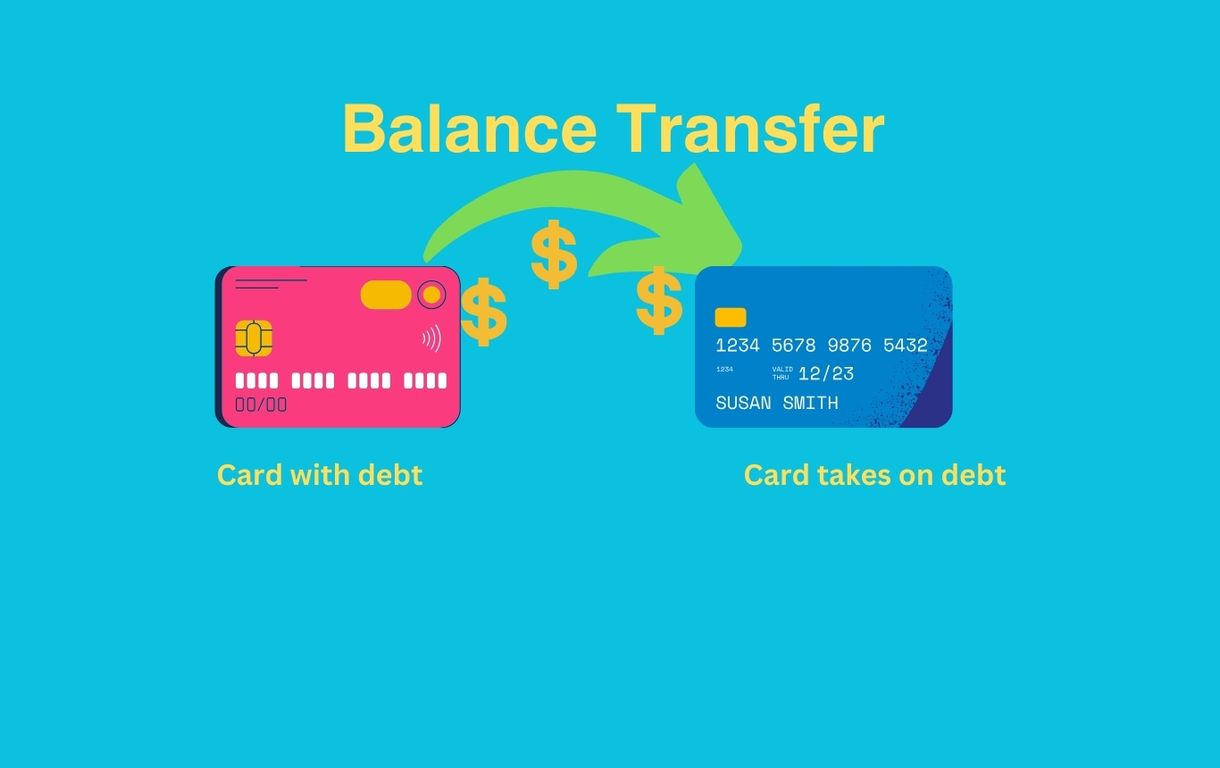
Getting through college is expensive. Between tuition, books, housing, and basic living expenses, the costs can quickly add up. Many students turn to credit cards to help cover these expenses. However, this can lead to high-interest credit card debt that takes years to pay off. A credit card balance transfer may provide some temporary financial relief.
What Is a Credit Card Balance Transfer?
Why You Need Balance Transfer Cards Them To Pay Off Debt Fast In 2024

A balance transfer allows you to move an outstanding balance from one credit card over to another card. Many credit card companies offer introductory 0% APR balance transfer offers as an incentive for new customers. During the intro period, which may last between 12 and 21 months, no interest accrues on the transferred balance. This gives you an interest-free period to pay down credit card debt faster.
Who Is Eligible for a Student Credit Card Balance Transfer?
To qualify for a balance transfer credit card, you’ll typically need:
- Good or excellent credit (credit scores of 690 or higher)
- A regular income to keep up with minimum payments
- Low existing balances relative to your available credit
As a student, you may have limited income and credit history. However, some banks offer student credit cards with balance transfer offers. Compare cards to find one that matches your credit profile.
Pros of Balance Transfers for Students
The biggest benefit of a balance transfer is avoiding interest charges. The average credit card interest rate currently sits around 19%. On a $2,000 balance, that’s $380 in interest fees yearly. A balance transfer resets the clock, so you won’t pay interest on the transferred amount for over a year.
Balance transfers also help simplify your finances. Combining multiple credit card balances onto one lower-interest or interest-free card makes managing debt easier. Setting up autopay helps build responsibility using credit as you diligently work toward reducing card balances.
Cons of Balance Transfers for Students
While balance transfers offer tempting benefits, know the potential downsides before applying:
- Balance transfer fees: Most cards charge a 3% to 5% balance transfer fee. On $5,000, that’s $150 to $250. Factor fees into the total repayment amount.
- Deferred interest: If not fully paid off during the intro 0% APR period, deferred interest typically back-dates to the original transfer date.
- Lower available credit: Transferring another card’s balance cuts into the available credit limit on the new card. Manage balances carefully to avoid maxing out cards.
- Marks on credit reports: While usually minimal, a hard credit check and increased credit utilization during balance transfers may negatively impact your credit score temporarily.
- Debt remains: A balance transfer clears card balances, but the debt still exists. Avoid racking balances back up during intro periods through responsible use of credit cards. Develop healthy spending habits instead of relying on short-term solutions.
How Do Balance Transfers Affect Your Credit?
Opening a new credit card and transferring high balances from other cards impacts your credit in a few ways:
- The new account lowers your average account age, modestly reducing credit scores. However, the effect reverses over time as the new card ages.
- Hard inquiries from credit card applications also ding scores slightly. But these only impact scores for 12 months and count much less than payment history.
- Increased utilization if transferring balances from multiple cards negatively affects credit initially. But as total owed decreases, scores rebound.
- Most importantly, responsibly managing new cards helps prove creditworthiness if card balances get paid on time each month during 0% APR periods. This builds positive payment history, raising credit scores over time.
While temporary setbacks are typical when opening new credit cards, focus on long-term benefits by diligently paying down balances interest-free.
How Much Credit Line Can Students Get?
As a student without much income or credit history, don’t expect massive credit limits right off the bat. Credit lines for student cards often start around $500. Balance transfer limits for students may fall in the range of $1,000 to $2,000 to start.
Carrying over higher balances requires cards designed for those with more robust qualifications. The good news is that responsible use of starter cards shows lenders your trustworthiness over time, opening doors to higher limits.
Balance Transfer Fees and Terms to Know
While the 0% APR is incentive enough, some other common fees and terms relate to balance transfers:
- Balance transfer fee – Many cards charge a one-time, upfront fee like 3% to 5% of the transfer amount. Factor this into the total savings calculation.
- Intro period length – The 0% term may last anywhere from 6 months to nearly two years. The longer the offer, the more interest you save.
- Deferred interest – If a balance remains after the intro period, deferred interest from the initial transfer(s) may kick in. Understand this implication.
- Credit limit – Ensure your total balances transferred fit below the approved card’s limit to avoid denial or complications.
Closely reviewing these terms and planning transfers carefully avoids surprises down the road.
How Do I Initiate a Balance Transfer?
Contact your new card provider to initiate balance transfers after approval. You can likely complete transfers conveniently through your account portal or a customer service agent.
- Gather account details for cards you wish to transfer from, including creditor names, account numbers, addresses etc.
- Enter details into the balance transfer form/request during or following application.
- Confirm transfer details like amounts and timing. Communicate any account closures needed to avoid complications.
- Make payments to your new card provider once transfers go through successfully.
- Confirm old accounts reflect transferred balances and no remaining charges incorrectly.
- Moving forward, focus repayments solely on the new transferred balance card within the intro 0% APR timeframe.
Stay organized when shifting balances between accounts and ask your provider any questions. They want to retain you as a long-term customer, so most offer excellent customer support.
Should I Close the Old Accounts?
An open question is whether to keep old credit lines open or close them out after transferring the balances away. Consider the pros and cons:
Pros of closing old card accounts:
- Avoid temptation to accrue new debt
- Simplify personal finances with fewer accounts
- No annual fees if applicable
Cons of closing old card accounts:
- Loss of available combined credit limit hurts credit utilization
- Reduces length of credit history impacting score
- Lose loyalty benefits on old cards
Ideally, close old accounts only if they charge expensive annual fees unlikely to be waived. Avoid closing your oldest card account regardless of temptation as this anchors your credit history length.
An intermediate step is to simply remove old cards from your wallet after transfers so they stay open long-term while going unused. This avoids actively using the accounts while keeping your credit foundation intact.
Evaluate factors like fees, account age, card benefits, and requested credit limits when deciding on account closure post transfer. Your credit score can fluctuate depending on how many and which accounts close.
Tips for Students Considering a Balance Transfer
If you have high-interest credit card debt as a college student, here are tips for utilizing balance transfers:
Shop Around for the Best Offers
[1]
Apply for cards offering 0% intro APR periods on balance transfers spanning 12 months or longer. Compare transfer fees and interest rates charged afterward. Consider perks like sign-up bonuses or rewards points too.
Transfer Only What You Can Pay Off
Don’t go overboard transferring every available balance. Move only an amount you can realistically budget to pay off before promotions end. Making minimum payments won’t cut it. Crunch numbers to calculate repayment amounts matching your income and expenses.
Pay Down Highest-Rate Cards First
If only partially consolidating card balances, transfer amounts residing on high-interest cards first. List card APRs and systematically pay down highest-rate cards. Transferring lower-rate plan balances won’t save as much money.
Set Up Autopay and Payment Alerts
Don’t risk missing payments after completing balance transfers. Set up autopay through bank accounts or debit cards. Also contact card issuers to establish payment due date alerts. These tools help organize finances.
Avoid Running Up More Debt
Stick to a reasonable budget that enables extra payments toward balances transferred over. Keep credit card spending minimal during the introductory period. Avoid wasting an interest-free opportunity by racking up more high-interest charges on new purchases.
Have a Backup Repayment Strategy
Build savings as balances decrease in case anything disrupts the repayment plan like losing a job or emergency costs. Savings provide flexibility managing financial hurdles. Also have an alternate approach, like student loans or family assistance, for repaying balances if unexpected events occur.
Questions to Ask Before Transferring Balances
Before submitting balance transfer applications, ask yourself these essential questions:
- How much existing credit card debt do I have in total? What interest rates am I currently paying?
- How much can I reliably budget each month toward paying down debt?
- How long will it take me to completely pay off the transferred balance amount based on my monthly payment capacity?
- Will I spend responsibly moving forward, avoiding new credit card charges during the intro 0% APR period?
- Do I understand exactly when the 0% rate promotion will end based on the terms?
- What interest rates or fees kick in after introductory offers expire?
- Do I have an emergency fund I can access if I temporarily struggle to make payments?
Doing a self-assessment ensures your financial situation fits reasonably with pursuing a balance transfer. Never view short-term promotions as quick fixes without dedication to developing healthy, long-term financial habits.
Next Steps: Finding the Best Student Balance Transfer Card
The offers introducing this article promote products from one or more of our advertisers and partners. We may receive compensation when you click on such links.
If you determine a balance transfer aligns well with your budget and repayment timeline as a college student, use the following tips to find the right card:
- Check your credit reports and scores so you know your standing when applying. Having credit scores around 690 improves approval odds for top balance transfer cards. [1]
- Research cards using choose-your-bonus tools that match bonuses to your credit. For students, options like the Discover it® Balance Transfer offer good bonuses with reasonable approval thresholds.
- Compare multiple card options side-by-side highlighting key factors like duration of 0% APR periods, balance transfer fees, regular APRs and credit required.
- Read issuer terms closely, so no surprises happen. Check when introductory offers expire and what corresponding interest rates apply afterward.
- Submit applications choosing cards well-suited for your financial situation. Only apply for an amount you know you can pay off responsibly based on your budget.
As you evaluate applications, don’t merely seek short-term incentives tied to large transfers. Make repayment capabilities your top priority for financial success.
Best Student Credit Cards for Balance Transfers
Students looking to transfer existing balances should focus on cards offering 0% intro APR periods. Low fees and customer perks add even more incentive.
Here are some top contenders for student card balance transfers:
- Discover it® Student Cash Back – 0% for 6 months on transfers made within 45 days of account opening. 5% cashback on rotating categories. [3].
- Citi Rewards+® Student Card – 0% for 12 months on transfers made in the first 4 months. 2x points at supermarkets and gas stations. [4]
- Bank of America® Customized Cash Rewards Credit Card for Students – 0% for 12 billing cycles on transfers made in first 60 days. 3% cash back category of your choice [5].
- Wells Fargo ReflectSM Card – 0% intro APR for 18 months with no transfer fees. Cell phone protection.
Always confirm full offer details on the provider’s website or by contacting them before applying.
Summarizing the Pros and Cons
In closing, weigh the notable pros against the cons to consider if pursuing a balance transfer makes sense:
Pros
- Lower interest expenses
- Consolidate multiple debts
- Motivates paying down balances faster
- Builds a positive credit history
Cons
- Balance transfer fees apply
- Need a good enough credit score to qualify
- The temporary 0% window eventually expires
- Old card closure impacts history and limits
Overall, balance transfers work wonderfully to ease financial strain and accelerate debt payoff – with proper planning and responsible use. Take advantage of 0% opportunities early on to establish robust credit. Just be sure to have an exit strategy before interest obligations
FAQs about Student balance transfer credit cards:
Are there student balance transfer credit cards?
Yes, some credit card companies like Discover, Citi, and Chase offer student cards with balance transfer options. These cards are specifically geared toward students building credit.
Can I use student balance transfer credit cards?
Yes, if you’re a student you can apply for a student credit card offering a balance transfer introductory offer. This allows for transferring high-interest debt from other cards.
What are student balance transfer credit cards?
Student balance transfer cards provide intro 0% APR periods to consolidate and repay credit card balances interest-free. They help students simplify finances and focus on paying down debt
Should I use student balance transfer credit cards?
If you have existing credit card debt with high interest rates, student cards with balance transfer offers provide a strategic way to save money and efficiently repay debts. But ensure you budget to pay off balances before promotions end.
Where to find student balance transfer credit cards?
Compare student cards from issuers like Discover, Citi, and Chase that frequently offer 12+ month 0% APR periods on transferred balances.

